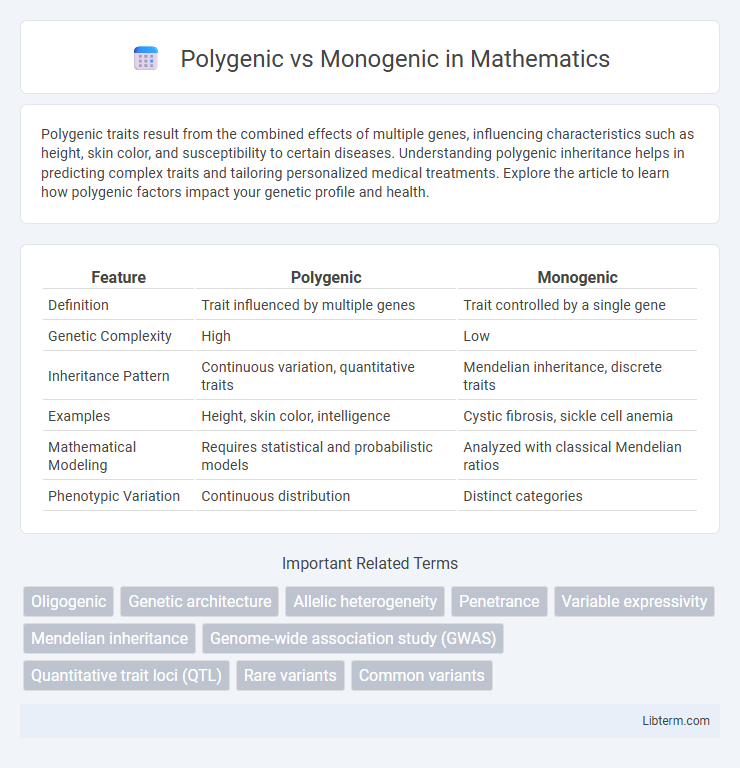Polygenic traits result from the combined effects of multiple genes, influencing characteristics such as height, skin color, and susceptibility to certain diseases. Understanding polygenic inheritance helps in predicting complex traits and tailoring personalized medical treatments. Explore the article to learn how polygenic factors impact your genetic profile and health.
Table of Comparison
| Feature | Polygenic | Monogenic |
|---|---|---|
| Definition | Trait influenced by multiple genes | Trait controlled by a single gene |
| Genetic Complexity | High | Low |
| Inheritance Pattern | Continuous variation, quantitative traits | Mendelian inheritance, discrete traits |
| Examples | Height, skin color, intelligence | Cystic fibrosis, sickle cell anemia |
| Mathematical Modeling | Requires statistical and probabilistic models | Analyzed with classical Mendelian ratios |
| Phenotypic Variation | Continuous distribution | Distinct categories |
Understanding Genetic Inheritance
Polygenic inheritance involves the combined effect of multiple genes contributing to a single trait, resulting in continuous variation such as height or skin color. Monogenic inheritance is controlled by a single gene, producing distinct, predictable phenotypes often observed in Mendelian disorders like cystic fibrosis or sickle cell anemia. Understanding these patterns helps clarify the complexity of genetic traits and their transmission across generations.
What Are Monogenic Traits?
Monogenic traits are determined by a single gene, resulting in distinct phenotypic expressions that follow Mendelian inheritance patterns. These traits often exhibit clear dominant or recessive modes of transmission, such as cystic fibrosis or sickle cell anemia. Understanding monogenic traits is crucial for genetic counseling and diagnosis of hereditary diseases caused by mutations in individual genes.
Characteristics of Polygenic Traits
Polygenic traits are controlled by multiple genes, each contributing a small effect, resulting in continuous variation within a population. Unlike monogenic traits governed by a single gene, polygenic traits exhibit a wide range of phenotypes, such as height, skin color, and intelligence. The additive effect of multiple alleles leads to complex inheritance patterns influenced by both genetics and environmental factors.
Key Differences: Polygenic vs Monogenic
Polygenic traits are influenced by multiple genes, each contributing a small effect, whereas monogenic traits result from mutations in a single gene with a direct and often significant impact. Polygenic inheritance exhibits continuous variation and complexity, commonly seen in traits like height or skin color, while monogenic inheritance follows Mendelian patterns with clear dominant or recessive alleles. Understanding these differences is crucial for genetic research, diagnosis, and treatment of diseases influenced by multiple genetic factors versus those caused by single-gene mutations.
Examples of Monogenic Disorders
Cystic fibrosis, sickle cell anemia, and Huntington's disease are prominent examples of monogenic disorders caused by mutations in a single gene. These conditions follow Mendelian inheritance patterns, resulting in distinct phenotypes determined by dominant or recessive alleles. Understanding monogenic disorders aids in genetic counseling and targeted therapies by pinpointing specific gene defects.
Examples of Polygenic Conditions
Polygenic conditions involve multiple genes contributing to the development of a trait or disorder, such as type 2 diabetes, hypertension, and schizophrenia. Unlike monogenic disorders caused by mutations in a single gene, polygenic diseases result from the combined effects of many genetic variants and environmental factors. This complex genetic architecture makes polygenic conditions more common and variable in expression compared to monogenic disorders like cystic fibrosis or sickle cell anemia.
Genetic Testing: Monogenic and Polygenic Approaches
Genetic testing for monogenic disorders targets specific gene mutations causing single-gene diseases, providing clear diagnostic results and guiding personalized medical decisions. Polygenic testing evaluates multiple genetic variants across the genome to assess the risk of complex diseases influenced by numerous genes, enhancing predictive accuracy for traits like heart disease and diabetes. Combining both approaches enables comprehensive genetic risk profiling, improving prevention strategies and tailored treatment plans.
Implications for Disease Prediction
Polygenic diseases result from the combined effect of multiple genes, each contributing a small risk, making disease prediction complex and requiring polygenic risk scores for accurate assessment. Monogenic diseases, caused by mutations in a single gene, allow for more straightforward genetic testing and clearer prediction of disease onset and inheritance patterns. Understanding whether a disease is polygenic or monogenic is crucial for personalized medicine strategies, impacting genetic counseling, risk assessment, and preventive measures.
Treatment Challenges and Opportunities
Polygenic disorders, influenced by multiple genes, present complex treatment challenges due to variable gene interactions and environmental factors, making personalized medicine approaches essential yet difficult to implement. Monogenic diseases, caused by mutations in a single gene, offer clearer targets for gene therapy and precision treatments, although rare mutations and gene heterogeneity still pose obstacles. Advances in genomics and CRISPR technology create opportunities to develop innovative therapies tailored to the genetic architecture of both polygenic and monogenic conditions.
Future Directions in Genetic Research
Future genetic research increasingly emphasizes polygenic risk scores to enhance personalized medicine by integrating multiple gene variants influencing complex traits. Advances in CRISPR and single-cell sequencing promise precise functional analysis of polygenic contributions alongside monogenic mutations. Machine learning algorithms are optimizing the interpretation of vast genomic datasets, enabling breakthroughs in understanding gene-gene interactions and disease susceptibility.
Polygenic Infographic

 libterm.com
libterm.com